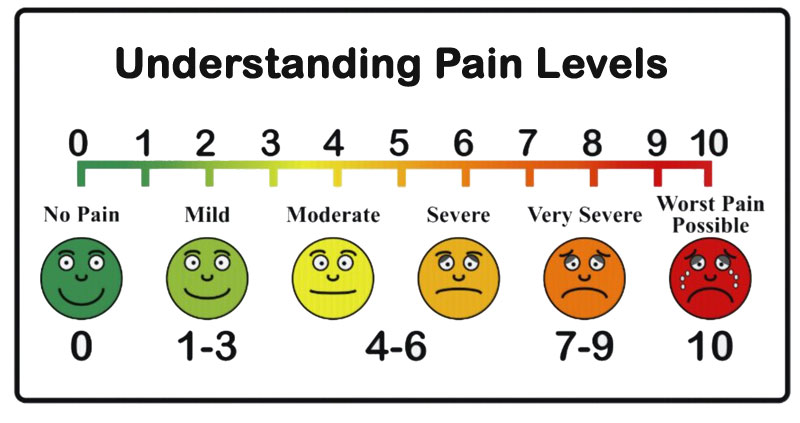Pain: Understanding Pain Levels, When to visit ER for Pain
Describing how pain levels and how pain feels can be the hardest thing in the world. Because pain is subjective, it is difficult to explain what you’re feeling to another person—even your primary doctor. To effectively use the pain scale, familiarize yourself with the levels before your procedure, identifying what key levels are indicative to your pain level. Following a surgery or procedure, typically we tell patients to continue to take medications that allow them to maintain a level of “5 or below.”
Despite difficulties in talking about pain, it’s the first thing an emergency room doctor or specialist will ask about when you see them for injury or illness, or when you’re discussing medication for ongoing, chronic pain. Pain Levels vary depending on the underlying condition causing the pain. It is important to visit the closest emergency room if your pain level affecting your daily activities and life.
If you want your pain to be taken seriously, It is important that you take the pain scale seriously.

Explaining Pain Levels
Doctors often ask patients to rate their pain level on a scale of 1 to 10. What emergency room doctors don’t give their patients is any indication of the standard pain level scale interpretations. Patients often find it puzzling to figure out what the doctor means and how they can choose a number to adequately express the severity of their pain.
The pain scale actually has standard explanations which divides pain into three categories ranging from mild for lower numbers, moderate to cover the middle numbers, and severe for numbers above seven. Even this isn’t very clear, however, because as previously stated mild or moderate pain means different things to different people. Most of us need a way to break down those categories a little further:
- 0 – Pain Free
- Mild Pain: (Nagging, annoying, but doesn’t really interfere with daily living activities)
- 1 – Pain is very mild, barely noticeable. Most of the time you don’t think about it
- 2 – Minor pain. Annoying and may have occasional stronger twinges.
- 3 – Pain is noticeable and distracting, however, you can get used to it and adapt
- Moderate Pain: (Interferes significantly with daily living activities)
- 4 – Moderate pain. If you are deeply involved in an activity, it can be ignored for a period of time, but is still distracting
- 5 – Moderately strong pain. It can’t be ignored for more than a few minutes, but with effort you still can manage to work or participate in some social activities
- 6 – Moderately strong pain that interferes with normal daily activities. Difficulty concentrating
- Severe Pain: (Disabling; unable to perform daily living activities)
- 7 – Severe pain that dominates your senses and significantly limits your ability to perform normal daily activities or maintain social relationships. Interferes with sleep
- 8 – Intense pain. Physical activity is severely limited. Conversing requires great effort
- 9 – Excruciating pain. Unable to converse. Crying out and/or moaning uncontrollably
- 10 – Unspeakable pain. Bedridden and possibly delirious. Very few people will ever experience this level of pain
The Pain Level and Children
Adults find it hard to describe levels of pain, but for children it’s practically impossible. Some variations of the pain scale use cartoon faces to indicate the types of feelings or emotions a person in pain may have, and these can be helpful when trying to understand a child’s pain.
When to Visit the Emergency Room
If you’ve been suffering from pain for a known condition for a while, it might not bring you to the nearest emergency room. Things to watch out for are when pain levels change significantly, or when you suddenly experience severe pain you haven’t felt before.
Pain is an indicator of an underlying condition, one which may have been developing for a while but which you were unaware of. An example could be chest pain. Cardiac disorders don’t come on overnight but develop over time and often we don’t realize anything is wrong until we feel pain. This is an example of a cause that has no visible signs, unlike bone fractures where it may be possible to see swelling or some deformity.
If you have unexpected or unexplained pain, there could be an underlying reason to visit the emergency room even if you don’t know what that reason is. Understanding the pain scale will help you accurately describe what you’re feeling, and help doctors give you the most effective medication.
If you are experiencing pain levels higher than you can tolerate, you should visit the closest ER.



.jpg)